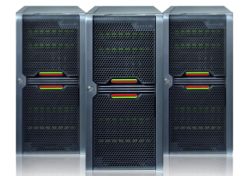Blog posts tagged servers
Why you should know what virtualisation is
 There’s a good chance you’ll have heard the term ‘virtualisation’ before. You might even have been told it’s a super-efficient way to set up the servers in your company.
There’s a good chance you’ll have heard the term ‘virtualisation’ before. You might even have been told it’s a super-efficient way to set up the servers in your company.
And it’s true: the arguments for virtualisation are impressive. It can make your organisation’s IT system more cost-effective, while also providing extra flexibility in the software you use every day.
However, although these benefits have made virtualisation more popular over the last few years, many companies still need help to understand the basics.
What is virtualisation?
In simple terms, virtualisation separates the software and the hardware on a server, creating a new go-between the two.
Picture an average server room belonging to a business. Typically, this room contains a bunch of servers stacked high with red and green blinking lights, buzzing with noise and generating a lot of heat.
(If you can’t picture it, the photo above is of a really big server room. Your company might only have one or two servers, but virtualisation can still be helpful.)
Each of these servers is running specific software, usually to perform a particular job, like managing your company’s email or customer database.
All these servers use electricity and cost you money to run.
The thing is, in reality each server is massively underused. You might think that your email server is working hard, but actually it might only be being used at 20% of its capacity. That’s really wasteful.
Enter virtualisation, which allows you to merge all these different servers onto a single server containing all the software and files that relate to the business.
Virtualisation is a form of consolidation. It brings several different servers together into one.
Now how does your server room look? Well, there are fewer machines, it’s less noisy, you’re using less electricity and your costs are lower too.
Virtualisation breaks with tradition
Traditionally, a single server was a specific piece of hardware installed with its own operating system and software.
The hardware and software were linked, so you had to choose a particular platform to use. Did you want a Windows server, a Linux server or a Mac server?
Virtualisation flips these conventions around, giving you more freedom and flexibility. If you have one or more servers in your business, it’s certainly worth investigating.
To learn more about how virtualisation works, see how one business replaced its old servers with virtualisation.
- How to do more with your network server
- Getting virtualisation right
- Is virtualisation a magical way to cut your costs?
This is a post from Akita, a company providing IT support and computer services to businesses in Kent and London.
How much computing power is wasted in your business?
This is a guest post from Integral IT, a Yorkshire IT support company.
 Relatively speaking, computers are cheap these days. You can purchase powerful servers and computers for surprisingly little money.
Relatively speaking, computers are cheap these days. You can purchase powerful servers and computers for surprisingly little money.
The thing is, most computers are used for day-to-day jobs like accessing the internet and creating presentations. And that means even the very cheapest have much more power than you're ever likely to use.
The same goes for servers, only the effect is even more pronounced. Plenty of businesses spend £1,000+ on a server, then end up using it to 10% - 20% capacity. Bonkers.
Use that power
So, there could be lots of spare computing power kicking around in your business. At first glance, it appears wasteful. But if you're about to buy even more new computer hardware, it seems crazy.
Virtualisation can help you use the spare capacity. It lets you take one computer, but split its resources (memory, disk space, processing power, etc) into several ‘virtual machines’.
Each virtual machine is like an individual computer. You can install software and use it as you wish.
Why virtualise?
When you create virtual machines, each one will have less computing capacity to call upon, because it has to share resources with other virtual machines. However, this doesn't matter if you're running everyday applications.
Here's an example. Say your main network server is running at 20% capacity. You can split it into four virtual machines, any of which can do that job - and there'll be a bit of spare capacity left, just in case.
If you're not trying to run really demanding software, virtualisation can be handy. For instance:
- Doing the job of several servers with one. You might not need separate servers for email, file storage and to run your customer database. Just create three virtual machines from one powerful server.
- Ditching desktop computers for thin clients. A thin client is little more than a keyboard and mouse which you connect to your computer network. Your staff use them as normal, but all the software runs on virtual machines at a central server.
- Running software for different operating systems. We talked about his before when we explained how to run Windows software on your Mac. You can use virtualisation to run Windows programs on your Mac, or to try Linux on your Windows computer.
The obvious upside of virtualisation is lower costs - you get more done with one piece of kit.
Getting started with virtualisation
Virtualisation isn't the easiest of technologies to get started with. Generally, you'll have to run some special software on your computer or server, so you can create virtual machines.
Common virtualisation software is provided by companies like VMWare and Citrix. However, as it can be tricky to get started with if you’re not technically minded, it's probably an idea to speak to an IT supplier.
Still, if you fancy trying virtualisation on your own computer, have a read of this guide on the Lifehacker website. Seeing it in action is a good way to get familiar with the concept, which can be a tricky one to grasp.



